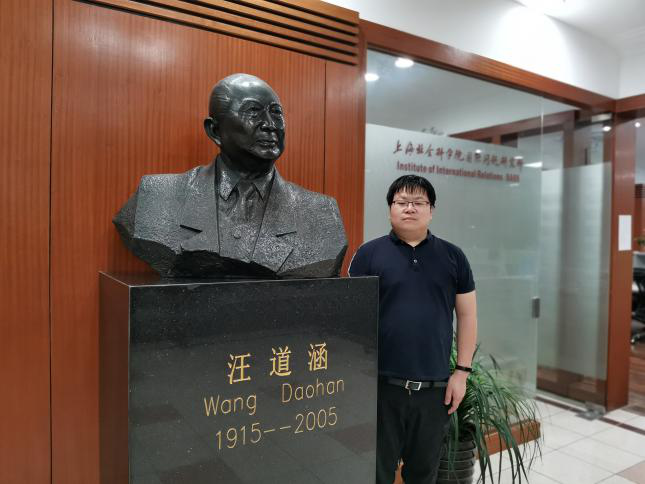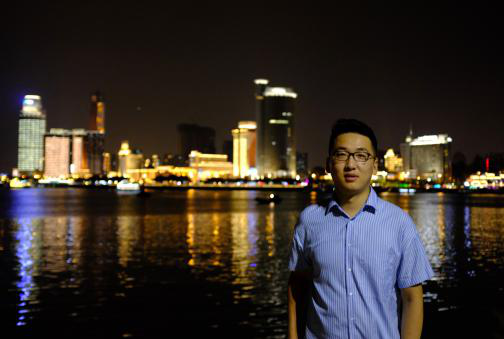
进院一年多来,2018年新进院青年科研人员积极参加学术交流活动和社会实践,在核心期刊论文发表、省部级以上课题立项、重要媒体文章发表、内部专报提交等方面均有上佳表现,展现了较强的科研能力和发展潜力。
本次推文将集中展示生态与可持续发展研究所杜红玉、国际问题研究所陈永、经济研究所李世奇、历史研究所蒋宏达四位青年科研人员在权威学术刊物上发表的论文。

杜红玉,1990年生人,来自黑龙江省哈尔滨市。博士毕业于华东师范大学生态学专业。现就职于上海社会科学院生态与可持续发展研究所。主要研究方向为:城市热环境研究、城市景观生态规划、城市绿地系统规划与可持续发展研究等。
近年来发表SCI/SSCI论文十余篇(其中以第一作者发表7篇);主持课题三项,分别为:一项国家自然科学基金青年课题,一项上海市哲学社会科学规划办青年课题(已结项:良好),一项上海社会科学院课题。
Combined Effects of the Surface Urban Heat Island with Landscape Composition and Configuration Based on Remote Sensing: A Case Study of Shanghai, China
Abstract: Rapid urbanization leads to changes in surface coverage and landscape patterns. This results in urban heat island (UHI) effects and a series of negative ecological consequences. Considering this concern and taking Shanghai as an example, this paper concentrates on the effects of surface coverage and landscape patterns on urban land surface temperature (LST). The research is based on quantitative retrieval of remote sensing data with consideration of methods in multiple disciplines, including landscape ecology, geographic information systems, and statistical analysis. It concludes that, over time, the thermal environment of Shanghai is becoming critical. The average LST ranking of different surface coverage is as follows: Construction land (CL) > bare land (BL) > green land (GL) > agricultural land (AL) > water body (WB). LST varies significantly with the type of surface coverage. CL contributes the most to the UHI, while WB and GL have obvious mitigation effects on the UHI. The large area, low degree of landscape fragmentation, and complex outlines lead to low LST rankings for GL, WB, and AL and a high LST ranking for CL. The conclusions indicate that CL should be broken down by GL and WB into discrete pieces to effectively mitigate UHI effects. The research reveals UHI features and changes in Shanghai over the years and provides practical advice that can be used by urban planning authorities to mitigate UHI.
Keywords: land surface temperature; land cover types; landscape pattern; urban heat island; remote sensing; Shanghai
本文刊发于《Sustainability》2019.05(SSCI/SCIE)
Urban blue-green space planning based on thermal environment simulation: A case study of Shanghai, China
Abstract:Improving the thermal environment of highly urbanized mega cities by optimized blue and green space brings great ecological and social benefits. In this study, applying remote sensing and Computational Fluid Dynamics (CFD) simulation, the Urban Cool Island (UCI) of blue and green space is explored. It indicates that complex outline of faceted water bodies leads to high UCI. Faceted water bodies have stronger UCI than linear ones. The UCI strength ranking of different types of green lands is wedge > radial > punctate > banding. The UCI distribution of green lands are different, which makes them appropriate in specific urban applications. Then, optimized design method of green lands and water bodies to maximize UCI is proposed, including integrating eco-system of green lands and water bodies, limiting riparian development, introducing artificial water within parks, inserting punctate green lands in old districts, setting green bands along roads in direction of prevailing wind and planning wedge green lands on the edge of cities. Finally, according to the optimized design method and the thermal environment simulation of Shanghai, strategy of distribution of blue and green space in urban planning to improve urban thermal environment is formulated, including polishing cool bands beside major and ring roads to increase permeability, inserting cool points into continuous UHI districts, protecting and improving cool surfaces on the edge of cities. The strategy is proved by simulation and provides hints for future planning of urban blue and green spaces.
Keywords: Blue and green space; Urban cool island; Thermal environment simulation; CFD
本文刊发于《Ecological Indcators》2019.11(SSCI/SCIE )
 陈永,上海社会科学院国际问题研究所助理研究员,毕业于北京大学国际关系专业,获法学博士学位。2018年7月进入上海社会科学院国际问题研究所工作。已在《世界经济与政治》《国际政治研究》和《国际论坛》等期刊发表数篇学术论文。博士论文被评为北京大学优秀博士学位论文。研究领域:美国海军政策、中美海上安全、海军发展比较研究。
陈永,上海社会科学院国际问题研究所助理研究员,毕业于北京大学国际关系专业,获法学博士学位。2018年7月进入上海社会科学院国际问题研究所工作。已在《世界经济与政治》《国际政治研究》和《国际论坛》等期刊发表数篇学术论文。博士论文被评为北京大学优秀博士学位论文。研究领域:美国海军政策、中美海上安全、海军发展比较研究。
精准修正主义与美国对华海上“灰色地带”策略
【内容提要】本文在既有研究的基础上指出,美国不是经典的现状国家,而是精准修正主义国家。美国基于国家利益需求精准修正国际海洋秩序中的一些制度和规则,推行其主张的海上安全秩序。美国不具有维护现状的道德优势。在海上安全竞争中,美国对中国采取叙事战争、议题联系、民事介入、自由航行、前沿存在和军事联盟等六类“灰色地带”策略。美国主要基于对中国军事实力的认知而选择“灰色地带”策略,主要目标是剥夺中国的“灰色地带”优势。美国在南海对中国采取了几乎“全光谱”的“灰色地带”策略,在印太区域主要采取非军事的“灰色地带”策略。中美的海上“灰色地带”竞争维持不会越过直接使用武力的门槛,但“灰色地带”竞争仍有引发中美军事冲突的危险,需要加以管控。
【关键词】 精准修正主义国家;灰色地带;南海;航行自由行动;中美海上安全竞争
本文刊发于《世界经济与政治》2019年第9期
 李世奇,经济学博士,上海社会科学院经济研究所助理研究员,主要从事区域创新发展研究、科技统计分析、宏观经济预测与政府政策评价。在《系统工程理论与实践》、《数量经济技术经济研究》、《南京社会科学》等权威期刊上发表论文十余篇。承担上海市哲学社会科学规划青年课题1项,参与国家自然科学基金2项、上海市软科学重点项目5项、上海市人民政府决策咨询研究重点专项课题1项。
李世奇,经济学博士,上海社会科学院经济研究所助理研究员,主要从事区域创新发展研究、科技统计分析、宏观经济预测与政府政策评价。在《系统工程理论与实践》、《数量经济技术经济研究》、《南京社会科学》等权威期刊上发表论文十余篇。承担上海市哲学社会科学规划青年课题1项,参与国家自然科学基金2项、上海市软科学重点项目5项、上海市人民政府决策咨询研究重点专项课题1项。
地方政府研发补贴的区域竞争
【摘要】通过构建中央政府干预的地方政府研发补贴区域竞争模型,运用空间面板方法基于中国31个省级地区2009-2015年的数据,分析地方政府在企业研发补贴上的区域竞争模式。研究发现,地方政府对国有企业的研发补贴呈现负的空间效应,地方政府采取相互替代的竞争策略,财政分权度系数显著为负说明国有企业所从事的基础性、全局性研发活动具有较大的外部性,地方政府对国有企业的研发补贴主要依靠中央政府的引导和支持,地方政府在国有企业研发补贴上的竞争实质上是对中央政府转移支付的竞争。对非国有企业的研发补贴则呈现正的空间效应,地方政府为了吸引和留住以市场为导向、流动性强的非国有创新企业采取相互模仿的竞争策略。研究结果表明,中央政府主导下的地方政府区域竞争会根据经济发展方式的变化而不断调整,竞争的对象向创新要素转移,充分体现了中国的制度优势以及市场在创新半岛电竞官方网站首页下载安卓 配置中的决定性作用。
本文刊发于《系统工程理论与实践》2019年第4期
 蒋宏达,2015年12月毕业于香港中文大学,获哲学博士学位。2016年至2017年在香港中文大学历史系从事博士后研究工作。2018年进入上海社会科学院历史研究所工作。目前主要致力于明代以来的社会经济史研究,关注明末清初及晚清民国初期史事。近作《明代军灶籍新证》《“丁”的层累演进》。
蒋宏达,2015年12月毕业于香港中文大学,获哲学博士学位。2016年至2017年在香港中文大学历史系从事博士后研究工作。2018年进入上海社会科学院历史研究所工作。目前主要致力于明代以来的社会经济史研究,关注明末清初及晚清民国初期史事。近作《明代军灶籍新证》《“丁”的层累演进》。
祭祀、控产与革命
——清末民初慈溪师桥的财产秩序和宗族演变
【摘要】清末民初,浙江慈溪师桥沈氏宗族的组织形态和财产结构发生了显著变化。清代中叶以前,为了应对频繁的水利纠纷,沈氏与毗邻的异姓家族结成祭祀联盟。甲午战争前后,随着中日两国机器棉纺织业的迅猛发展,杭州湾南岸滨海沙涂被大规模开发成棉田,原先的水利祭祀联盟逐渐向沙涂控产组织转化。清末新政以后,地方权势沉浮不定,沙涂控产组织日益遭受内部冲突和外部“民变”风潮的冲击。北伐战争时期,内外矛盾汇聚成农民运动,严重冲击了乡村传统支配势力,从而使地方社会秩序陷入涣散、解体的危机。为纾解这一困境,传统的水利祭祀联盟和宗族控产结构被重新恢复,师桥地方产生“大革命”复活“旧制度”的悖论现象,地方社会在革命之后呈现新旧杂糅的面貌。
本文刊发于《近代史研究》2019年第1期
